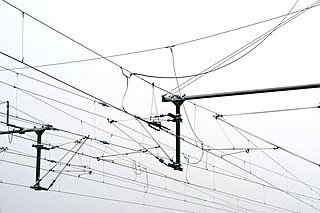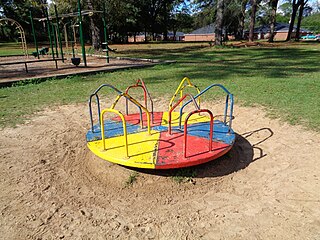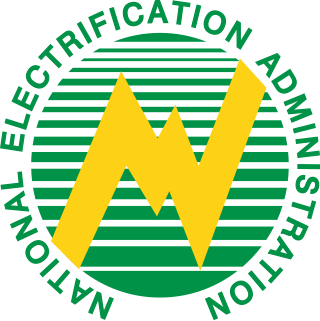
Electricity generation is the process of generating electric power from sources of primary energy. For utilities in the electric power industry, it is the stage prior to its delivery to end users or its storage.

An overhead line or overhead wire is an electrical cable that is used to transmit electrical energy to electric locomotives, trolleybuses or trams. It is known variously as:

Electric power distribution is the final stage in the delivery of electric power; it carries electricity from the transmission system to individual consumers. Distribution substations connect to the transmission system and lower the transmission voltage to medium voltage ranging between 2 kV and 35 kV with the use of transformers. Primary distribution lines carry this medium voltage power to distribution transformers located near the customer's premises. Distribution transformers again lower the voltage to the utilization voltage used by lighting, industrial equipment and household appliances. Often several customers are supplied from one transformer through secondary distribution lines. Commercial and residential customers are connected to the secondary distribution lines through service drops. Customers demanding a much larger amount of power may be connected directly to the primary distribution level or the subtransmission level.

An alternator is an electrical generator that converts mechanical energy to electrical energy in the form of alternating current. For reasons of cost and simplicity, most alternators use a rotating magnetic field with a stationary armature. Occasionally, a linear alternator or a rotating armature with a stationary magnetic field is used. In principle, any AC electrical generator can be called an alternator, but usually the term refers to small rotating machines driven by automotive and other internal combustion engines.
Electrification is the process of powering by electricity and, in many contexts, the introduction of such power by changing over from an earlier power source.

A roundabout, merry-go-round, or carousel is piece of playground equipment, a flat disk, frequently about 2 to 3 metres in diameter, with bars on it that act as both hand-holds and something to lean against while riding. The disk can be made to spin by pushing or pulling on its handles, either by running around the outside, or by pulling and re-grabbing as it spins, from a stationary stance. If the disk is mounted at a tilt to the ground, after an initial push, the disk can be speeded up without further pushing or touching the ground. The trick is to have the rider(s) lean into the center of the disk while ascending and leaning out from the center when descending. It is the physics of Angular Momentum and also works for swings. Often found in school playgrounds and public parks, they offer riders a dizzying ride when either others spin the wheel, or by spinning it themselves by running around it, and then jumping on. People may take turns between riding and spinning. One type of roundabout which differs significantly in terms of how the rotary motion is provided is a Swedish device called the HAGS Pedal Roundabout, which resembles four small exercise bikes attached to a tubular steel ring, which travel on a circular steel rail on the ground. The ring is attached to a vertical pole in the center by four spokes. There is a driving wheel hidden under the casing of each of the "exercise bikes" and the roundabout is turned by the pedaling action of the riders.

A lineworker constructs and maintains the electric transmission and distribution facilities that deliver electrical energy to industrial, commercial, and residential establishments. A lineworker installs, services, and emergency repairs electrical lines in the case of lightning, wind, ice storm, or ground disruptions. Whereas lineworkers generally work at outdoor installations, those who install and maintain electrical wiring inside buildings are electricians.
An atomic battery, nuclear battery, radioisotope battery or radioisotope generator is a device which uses energy from the decay of a radioactive isotope to generate electricity. Like nuclear reactors, they generate electricity from nuclear energy, but differ in that they do not use a chain reaction. Although commonly called batteries, they are technically not electrochemical and cannot be charged or recharged. They are very costly, but have an extremely long life and high energy density, and so they are typically used as power sources for equipment that must operate unattended for long periods of time, such as spacecraft, pacemakers, underwater systems and automated scientific stations in remote parts of the world.

Rural electrification is the process of bringing electrical power to rural and remote areas. Rural communities are suffering from colossal market failures as the national grids fall short of their demand for electricity. As of 2017, over 1 billion people worldwide lack household electric power – 14% of the global population. Electrification typically begins in cities and towns and gradually extends to rural areas, however, this process often runs into obstacles in developing nations. Expanding the national grid is expensive and countries consistently lack the capital to grow their current infrastructure. Additionally, amortizing capital costs to reduce the unit cost of each hook-up is harder to do in lightly populated areas. If countries are able to overcome these obstacles and reach nationwide electrification, rural communities will be able to reap considerable amounts of economic and social development.
Saskatchewan Power Corporation, operating as SaskPower, is the principal electric utility in Saskatchewan, Canada. Established in 1929 by the provincial government, it serves more than 538,000 customers and manages over $11.8 billion in assets. SaskPower is a major employer in the province with over 3,100 permanent full-time staff located in approximately 70 communities.

The Solar Electric Light Fund (SELF) is a non-profit organization established and based in Washington, D.C. whose mission is to design and implement solar energy solutions to assist those living in economic community with low level of energy, educational, health care, and agricultural development. Since 1990, SELF has completed projects in more than 20 countries, using solar energy to power drip irrigation in Benin, health care in Haiti, telemedicine in the Amazon rainforest, online learning in South Africa, and microenterprise development in Nigeria.

Electric power is the rate at which electrical energy is transferred by an electric circuit. The SI unit of power is the watt, one joule per second.
Charles Hesterman Merz was a British electrical engineer who pioneered the use of high-voltage three-phase AC power distribution in the United Kingdom, building a system in the North East of England in the early 20th century that became the model for the country's National Grid.
For solar power, South Asia has the ideal combination of both high solar insolation and a high density of potential customers.

The developing nations of Africa are popular locations for the application of renewable energy technology. Currently, many nations already have small-scale solar, wind, and geothermal devices in operation providing energy to urban and rural populations. These types of energy production are especially useful in remote locations because of the excessive cost of transporting electricity from large-scale power plants. The applications of renewable energy technology has the potential to alleviate many of the problems that face Africans every day, especially if done in a sustainable manner that prioritizes human rights.

A solar lamp, also known as a solar light or solar lantern, is a lighting system composed of a LED lamp, solar panels, battery, charge controller and there may also be an inverter. The lamp operates on electricity from batteries, charged through the use of solar panel

An electrical grid is an interconnected network for electricity delivery from producers to consumers. Electrical grids vary in size and can cover whole countries or continents. It consists of:
Husk Power Systems, founded in 2008, is a company based in Fort Collins, Colorado, US, that provides clean energy services to off-grid or weak grid rural communities in East Africa, West Africa and South Asia, primarily by building renewable energy mini-grids/micro-grids. Its original technology generated electricity using a biomass gasifier that created fuel from rice husks, a waste product of rice hullers that separate the husks as chaff from the rice, a staple food in both Asia and Africa. In the mid-2010s, with the rapid decline in the price of solar PV and batteries, Husk pivoted its business model to focus more on solar-plus-storage mini-grids, while continuing to use biomass in combination with solar to serve communities with larger electricity demand. In 2021, Husk Power was recognized in the REN21 Renewables Global Status Report as the first mini-grid company to achieve significant scale, by surpassing 100 solar hybrid community mini-grids, and 5,000 small business customers. In 2022, Husk signed an Energy Compact with the United Nations, in which it set a target of building 5,000 mini-grids and connecting 1 million customers by 2030.
The Agency for New and renewable Energy Research & Technology (ANERT) is a government agency in the Kerala, India. Its mission is gathering and disseminating knowledge about renewable energy, energy conservation, and rural technology. The agency was established in 1986 with its headquarters at Thiruvananthapuram.

The National Electrification Administration is a government-owned and controlled corporation (GOCC) attached to the Department of Energy of the Philippines tasked in the full implementation of the rural electrification program (REP) and reinforce the technical capability and financial viability of the 121 rural electric cooperatives (ECs).















